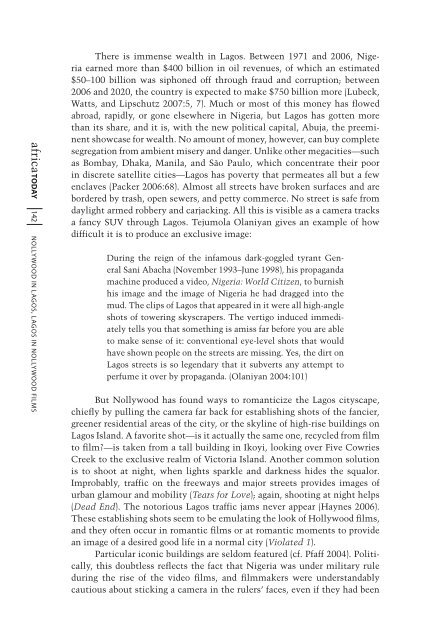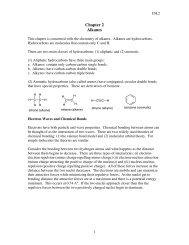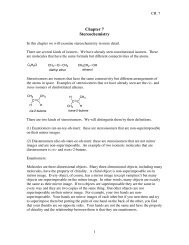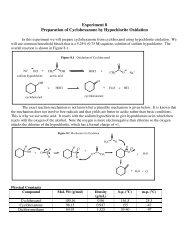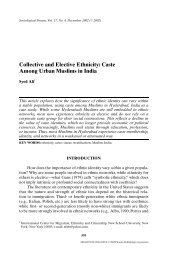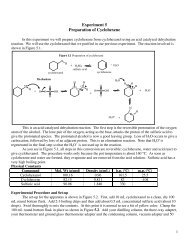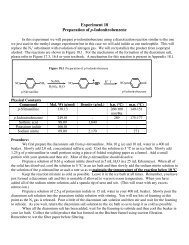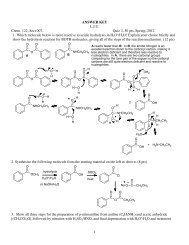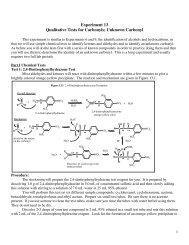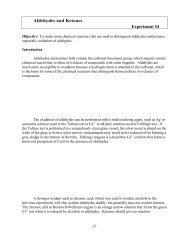are <strong>in</strong> <strong>the</strong> hands <strong>of</strong> even more predatory figures, who charge exorbitant feesand block moves to provide runn<strong>in</strong>g water because it would reduce <strong>the</strong>irbus<strong>in</strong>ess. As Gandy emphasizes, <strong>the</strong>re <strong>is</strong> an ideological vacuum where <strong>the</strong>reshould be a public sphere, or ra<strong>the</strong>r a spl<strong>in</strong>ter<strong>in</strong>g <strong>in</strong>to ethnic and religiousextrem<strong>is</strong>ms and <strong>the</strong> pursuit <strong>of</strong> <strong>in</strong>dividual advancement through patronagenetworks, strategies <strong>that</strong> prom<strong>is</strong>e a measure <strong>of</strong> control over immediateenvironments <strong>in</strong> <strong>the</strong> face <strong>of</strong> an admittedly <strong>in</strong>tractable whole. Th<strong>is</strong> means<strong>that</strong> <strong>the</strong> situation <strong>is</strong> likely to stay <strong>the</strong> same because <strong>the</strong>re <strong>is</strong> <strong>in</strong>sufficientpolitical pressure to br<strong>in</strong>g about <strong>the</strong> needed enormous <strong>in</strong>vestments <strong>in</strong><strong>in</strong>frastructure. It also means <strong>that</strong> coherence <strong>is</strong> hard to achieve, even on <strong>the</strong>conceptual level, ei<strong>the</strong>r <strong>in</strong> popular consciousness, or at <strong>the</strong> urban-plann<strong>in</strong>glevel (Gandy 2006).Of course almost every African city <strong>is</strong> a mess; <strong>Lagos</strong> <strong>is</strong> only <strong>the</strong> biggest.The two–cities-<strong>of</strong>-colonial<strong>is</strong>m <strong>the</strong>me was articulated <strong>in</strong> classic formby Frantz Fanon <strong>in</strong> The Wretched <strong>of</strong> <strong>the</strong> Earth (1968), and Roy Armes hasshown how it <strong>in</strong>forms <strong>the</strong> treatment <strong>of</strong> space <strong>in</strong> <strong>the</strong> symbolically found<strong>in</strong>gfilm <strong>of</strong> African c<strong>in</strong>ema, Ousmane Sembene’s Borom Sarret (Malkmus andArmes 1991:186–187). Franço<strong>is</strong>e Pfaff <strong>in</strong>troduces a study <strong>of</strong> “African Citiesas C<strong>in</strong>ematic Texts” <strong>in</strong> Francophone African celluloid filmmak<strong>in</strong>g by say<strong>in</strong>g“Nowhere but <strong>in</strong> contemporary African cities <strong>is</strong> <strong>the</strong> clash between traditionand modernity better expressed. And it <strong>is</strong> prec<strong>is</strong>ely <strong>the</strong> dramatic rendition<strong>of</strong> th<strong>is</strong> <strong>the</strong>me <strong>that</strong> lies at <strong>the</strong> core <strong>of</strong> <strong>the</strong> greatest number <strong>of</strong> African <strong>films</strong>,especially those set <strong>in</strong> urban contexts” (Pfaff 2004:89).It <strong>is</strong> possible to f<strong>in</strong>d Nollywood <strong>films</strong> <strong>in</strong> which a polarity between“tradition” and “modernity” <strong>is</strong> operat<strong>in</strong>g, but th<strong>is</strong> polarity does <strong>not</strong> structure<strong>the</strong> imagery <strong>of</strong> Nollywood <strong>films</strong> <strong>in</strong> general. The architecture and monumentsassociated with colonial<strong>is</strong>m <strong>that</strong> Pfaff f<strong>in</strong>ds so prevalent are almost entirelyabsent; <strong>the</strong> population <strong>of</strong> Nollywood, as <strong>of</strong> <strong>Lagos</strong>, <strong>is</strong> young and does <strong>not</strong>remember <strong>the</strong> colonial era. The high end <strong>of</strong> <strong>the</strong> <strong>Lagos</strong> cityscape was formedby <strong>the</strong> era <strong>of</strong> oil-boom-fueled heroic national aspiration <strong>of</strong> <strong>the</strong> 1960s and1970s, with its freeways and grandiose public build<strong>in</strong>gs, and <strong>the</strong> era <strong>of</strong> neoliberalkleptocracy <strong>that</strong> followed. Money, ra<strong>the</strong>r than race, has for decades been<strong>the</strong> structur<strong>in</strong>g pr<strong>in</strong>ciple, and though class div<strong>is</strong>ions are exceptionally sharpand v<strong>is</strong>ible <strong>in</strong> <strong>Lagos</strong>, <strong>the</strong>y are permeable (Olaniyan 2004:89–90)—doubtlessmuch more permeable <strong>in</strong> imag<strong>in</strong>ation than <strong>in</strong> reality, and Nollywood <strong>is</strong> allabout sell<strong>in</strong>g <strong>the</strong> dream <strong>of</strong> <strong>in</strong>dividual advancement. As has been frequentlyobserved, <strong>the</strong> hope <strong>of</strong> <strong>in</strong>dividual advancement has been a formidable obstacleto <strong>the</strong> formation <strong>of</strong> class consciousness <strong>in</strong> Nigeria (Barber 1987; Jeyifo 1984;Waterman 1990; Williams 1974). Wealthy neighborhoods are now desired,ra<strong>the</strong>r than seen under <strong>the</strong> sign <strong>of</strong> exclusion, alienation, and d<strong>is</strong>orientation,as <strong>in</strong> Borom Sarret. 5 Rich and poor coex<strong>is</strong>t on <strong>in</strong>timate terms <strong>in</strong> a state<strong>of</strong> <strong>in</strong>complete class formation. Many extended families <strong>in</strong>clude someonewith money, or at least a relationship with a wealthy patron; no extendedfamily <strong>is</strong> without many poor relations. Hopes for spectacular social promotionand fear <strong>of</strong> social collapse are almost universal and are <strong>the</strong> essentialsocioemotional matrix <strong>of</strong> <strong>the</strong> images <strong>of</strong> <strong>the</strong> <strong>films</strong>.africa today 141 Jonathan Haynes
africa today 142 Nollywood <strong>in</strong> <strong>Lagos</strong>, <strong>Lagos</strong> <strong>in</strong> Nollywood FilmsThere <strong>is</strong> immense wealth <strong>in</strong> <strong>Lagos</strong>. Between 1971 and 2006, Nigeriaearned more than $400 billion <strong>in</strong> oil revenues, <strong>of</strong> which an estimated$50–100 billion was siphoned <strong>of</strong>f through fraud and corruption; between2006 and 2020, <strong>the</strong> country <strong>is</strong> expected to make $750 billion more (Lubeck,Watts, and Lipschutz 2007:5, 7). Much or most <strong>of</strong> th<strong>is</strong> money has flowedabroad, rapidly, or gone elsewhere <strong>in</strong> Nigeria, but <strong>Lagos</strong> has gotten morethan its share, and it <strong>is</strong>, with <strong>the</strong> new political capital, Abuja, <strong>the</strong> preem<strong>in</strong>entshowcase for wealth. No amount <strong>of</strong> money, however, can buy completesegregation from ambient m<strong>is</strong>ery and danger. Unlike o<strong>the</strong>r megacities—suchas Bombay, Dhaka, Manila, and São Paulo, which concentrate <strong>the</strong>ir poor<strong>in</strong> d<strong>is</strong>crete satellite cities—<strong>Lagos</strong> has poverty <strong>that</strong> permeates all but a fewenclaves (Packer 2006:68). Almost all streets have broken surfaces and arebordered by trash, open sewers, and petty commerce. No street <strong>is</strong> safe fromdaylight armed robbery and carjack<strong>in</strong>g. All th<strong>is</strong> <strong>is</strong> v<strong>is</strong>ible as a camera tracksa fancy SUV through <strong>Lagos</strong>. Tejumola Olaniyan gives an example <strong>of</strong> howdifficult it <strong>is</strong> to produce an exclusive image:Dur<strong>in</strong>g <strong>the</strong> reign <strong>of</strong> <strong>the</strong> <strong>in</strong>famous dark-goggled tyrant GeneralSani Abacha (November 1993–June 1998), h<strong>is</strong> propagandamach<strong>in</strong>e produced a video, Nigeria: World Citizen, to burn<strong>is</strong>hh<strong>is</strong> image and <strong>the</strong> image <strong>of</strong> Nigeria he had dragged <strong>in</strong>to <strong>the</strong>mud. The clips <strong>of</strong> <strong>Lagos</strong> <strong>that</strong> appeared <strong>in</strong> it were all high-angleshots <strong>of</strong> tower<strong>in</strong>g skyscrapers. The vertigo <strong>in</strong>duced immediatelytells you <strong>that</strong> someth<strong>in</strong>g <strong>is</strong> am<strong>is</strong>s far before you are ableto make <strong>sense</strong> <strong>of</strong> it: conventional eye-level shots <strong>that</strong> wouldhave shown people on <strong>the</strong> streets are m<strong>is</strong>s<strong>in</strong>g. Yes, <strong>the</strong> dirt on<strong>Lagos</strong> streets <strong>is</strong> so legendary <strong>that</strong> it subverts any attempt toperfume it over by propaganda. (Olaniyan 2004:101)But Nollywood has found ways to romanticize <strong>the</strong> <strong>Lagos</strong> cityscape,chiefly by pull<strong>in</strong>g <strong>the</strong> camera far back for establ<strong>is</strong>h<strong>in</strong>g shots <strong>of</strong> <strong>the</strong> fancier,greener residential areas <strong>of</strong> <strong>the</strong> city, or <strong>the</strong> skyl<strong>in</strong>e <strong>of</strong> high-r<strong>is</strong>e build<strong>in</strong>gs on<strong>Lagos</strong> Island. A favorite shot—<strong>is</strong> it actually <strong>the</strong> same one, recycled from filmto film?—<strong>is</strong> taken from a tall build<strong>in</strong>g <strong>in</strong> Ikoyi, look<strong>in</strong>g over Five CowriesCreek to <strong>the</strong> exclusive realm <strong>of</strong> Victoria Island. Ano<strong>the</strong>r common solution<strong>is</strong> to shoot at night, when lights sparkle and darkness hides <strong>the</strong> squalor.Improbably, traffic on <strong>the</strong> freeways and major streets provides images <strong>of</strong>urban glamour and mobility (Tears for Love); aga<strong>in</strong>, shoot<strong>in</strong>g at night helps(Dead End). The <strong>not</strong>orious <strong>Lagos</strong> traffic jams never appear (Haynes 2006).These establ<strong>is</strong>h<strong>in</strong>g shots seem to be emulat<strong>in</strong>g <strong>the</strong> look <strong>of</strong> Hollywood <strong>films</strong>,and <strong>the</strong>y <strong>of</strong>ten occur <strong>in</strong> romantic <strong>films</strong> or at romantic moments to providean image <strong>of</strong> a desired good life <strong>in</strong> a normal city (Violated 1).Particular iconic build<strong>in</strong>gs are seldom featured (cf. Pfaff 2004). Politically,th<strong>is</strong> doubtless reflects <strong>the</strong> fact <strong>that</strong> Nigeria was under military ruledur<strong>in</strong>g <strong>the</strong> r<strong>is</strong>e <strong>of</strong> <strong>the</strong> video <strong>films</strong>, and filmmakers were understandablycautious about stick<strong>in</strong>g a camera <strong>in</strong> <strong>the</strong> rulers’ faces, even if <strong>the</strong>y had been


